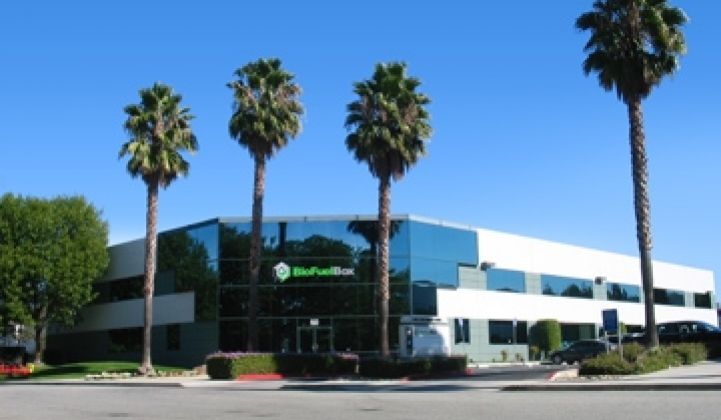It's all about using the stuff that nobody else wants.
BioFuelBox, a three year-old startup with a technology to make biodiesel out of the nasty, scummy water used to flush out grease traps, recently raised $5.2 million of a planned $14.9 million second round of investment, according to a December regulatory filing with the Securities and Exchange Commission.
That comes on top of the $9.5 million the San Jose, Calif.-based startup raised in a Series A round with Draper Fisher Jurvetson and Element Partners in 2007 (see Green Light post).
As for the modular, skid-mounted, one million gallon-per-year refineries the company makes, the first pilot plant has been up and running in Idaho since September.
The system takes greasy water a nearby wastewater treatment plant, which funnels the waste from restaurants and food processing plants, and turns it into biofuel to be sold to the Flying J truck stop chain, Rick Reddy, vice president of marketing, said in a Thursday interview.
BioFuelBox finances, owns and operates the system, which also puts out de-greased water that's easier for the wastewater treatment plant to deal with, said Reddy, who declined to comment on the report of the company's second round of funding.
It's not the only startup looking to capture wastewater and extract fuel from it. Applied Cleantech, a startup with a method of extracting cellulose from sewage, has teamed up with biofuel startup Qteros to build a demonstration plant to convert wastewater to ethanol (see Qteros, Applied CleanTech Look to Sewage for Biofuel). A number of algae-to-biofuel companies are looking to wastewater to serve as a fertile medium to grow their algae (see Green Light post).
But the greasy water – wastewater FOG, in industry parlance, with up to 95 percent water by weight – that BioFuelBox is targeting has until now been deemed uneconomical for a biofuel feedstock, something Reddy said the company has solved with its Novostream technology. It combines mechanical systems for removing most of the water from the input stream, and then a high-heat, high-pressure technology developed by Chief Scientist Greg Anderson and partly based on "supercritical fluid extraction" technology developed at the Department of Energy's Idaho National Laboratory, to turn it into biodiesel, Reddy said.
While using heat to extract useful fats and oils does add to the energy costs of the process, the fact that BioFuelBox gets its feedstock for free helps balance that out, he said, though he wouldn't cite production costs for the process.
"We co-locate on the site of the waste generator, and take that waste form them for free, for 10 to 20 years, and convert that into the cleanest-burning, lowest-emission transportation fuel," he said.
BioFuelBox has already lined up customers for five more 1 million gallon-per-year plants, Reddy said, though he wouldn't name them. The company is also in discussions with large-scale fuel distribution companies to take the biodiesel to market, he said.
About 100 cities in the United States are big enough to handle at least one BioFuelBox plant, he estimated. Industrial food processors are another target market, he said.
With an estimated 12 billion gallons per year of wastewater FOG being produced around the world, BioFuelBox sees the potential to start building hundreds of its modular refineries per year, and is now seeking to build up the manufacturing capacity to meet its current backlog, he said.
BioFuelBox was named a 2010 Technology Pioneer by the World Economic Forum earlier this month, one of 26 companies to be picked by the Davos, Switzerland group. Other greentech winners include stealthy fuel cell startup Bloom Energy and green building startup Serious Materials.
Photo of BioFuelBox's headquarters via the company.



